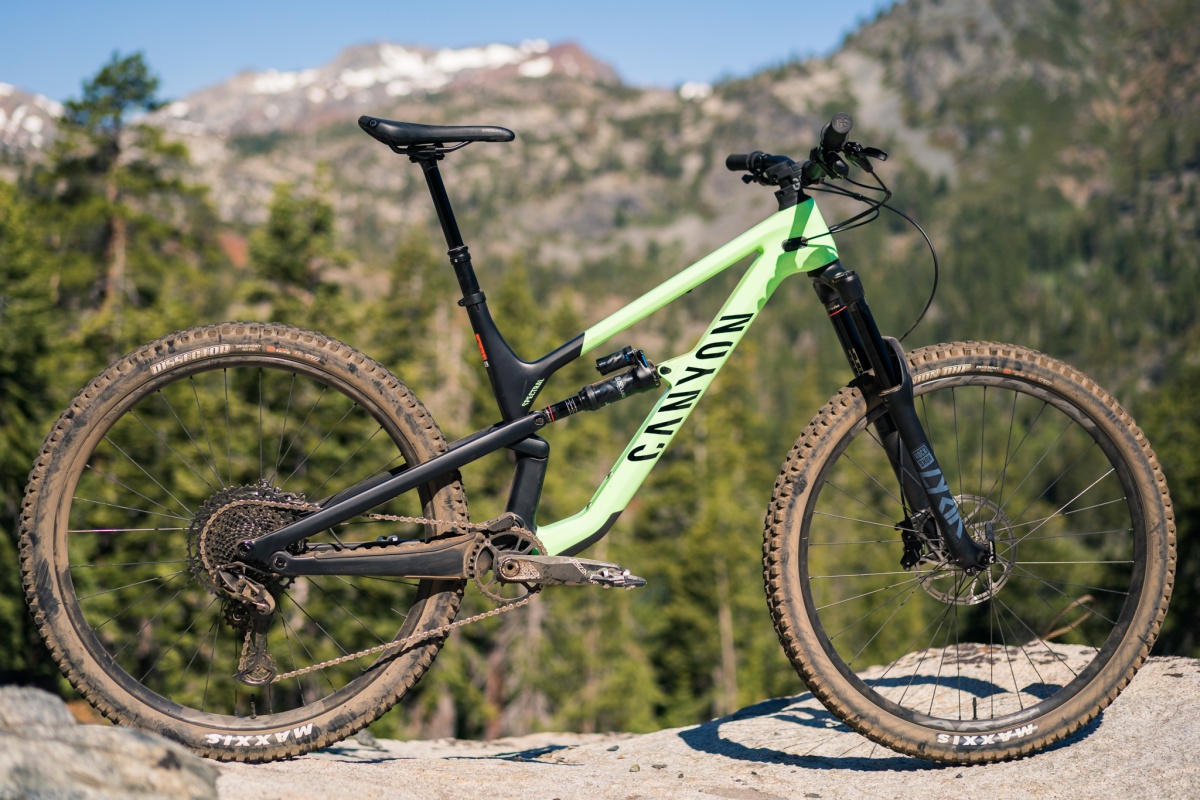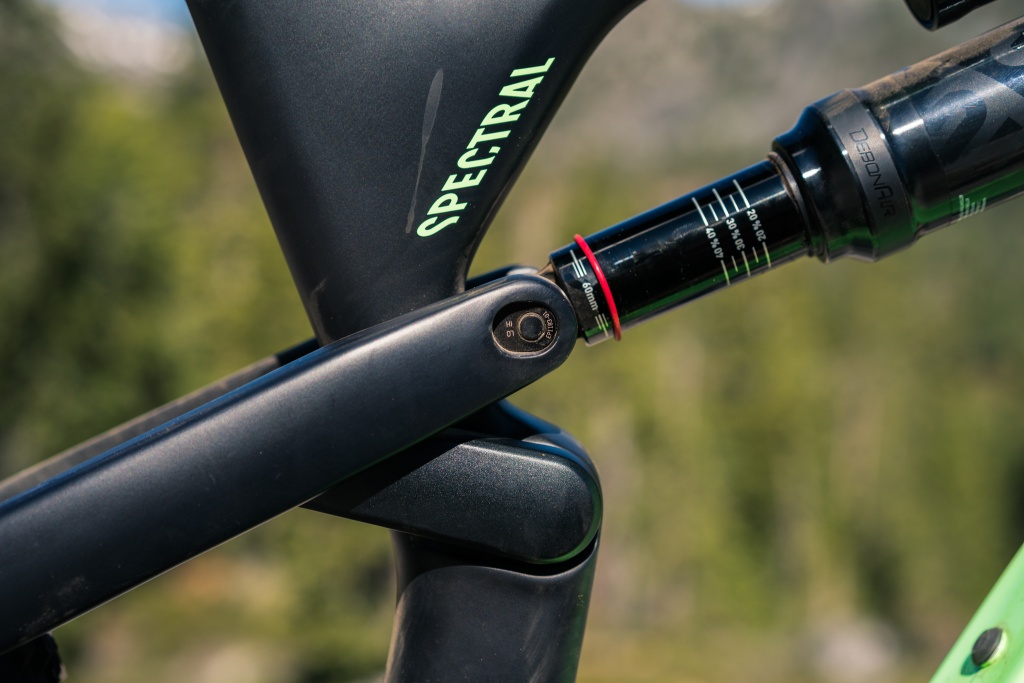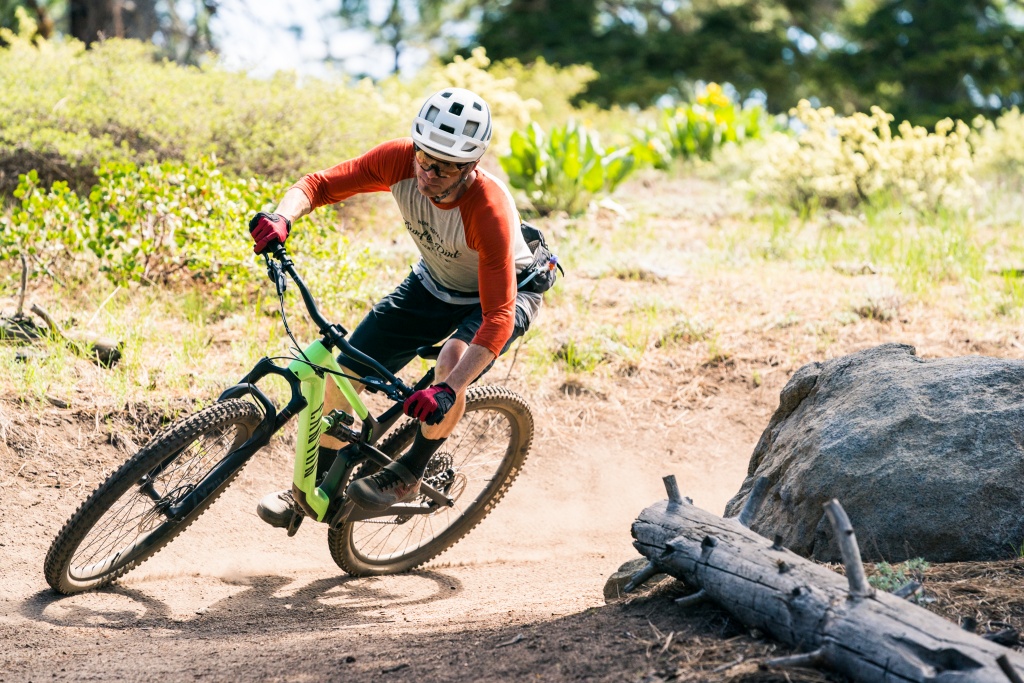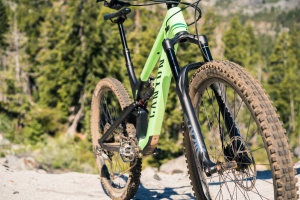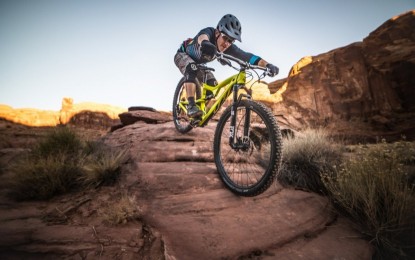Canyon Spectral 29 CF 7 Review
Our Verdict
Our Analysis and Test Results
Should I Buy This Bike?
Canyon's new Spectral 29 is an aggressive longer travel trail bike that combines excellent downhill shredding capabilities with a very respectable climbing performance. This 150mm travel 29er comes with a 160mm fork and a modern geometry that borders on enduro bike territory. In fact, the Spectral 29 is both slacker and longer than Canyon's current Strive enduro bike. This bike feels like a captive wild stallion set loose, it just wants to stretch its legs and run. Point this bike downhill and it picks up speed in a hurry with impressive stability at speed and angles that inspire the confidence to push it hard and point it down steep and chunky descents. At the same time, its handling feels crisp and responsive, and it's easy to place this bike where you want it in corners, hold your line, and look further down the trail. Canyon's Triple Phase suspension design works impressively well, with a supple feel off the top, mid-stroke support to provide a little pep, and solid big hit performance with enough progression to keep you from finding the end of the travel. Given its descending prowess, the Spectral 29 is an impressive climber. The pedaling platform is remarkably calm and supportive, and the geometry is dialed for grinding up steep trails and roads. Due to this bike's overall length and slack front end, however, both uphill and downhill handling can feel a little sluggish and awkward at lower speeds and in tighter terrain. We feel like it might be a little too much bike for mellower riders and trails. This carbon-framed beauty has nice lines and a solid build kit that isn't perfect, but mostly dialed for the price. Plus, it gets delivered straight to your door with minimal assembly required. If you're an aggressive rider seeking a longer travel trail bike that climbs efficiently and shreds downhill with authority, we think the Spectral 29 is a great option to consider.
The Spectral 29 CF 7 is very similar to the new Specialized Stumpjumper EVO Carbon Comp we recently tested. Both bikes roll on 29-inch wheels with 150mm of Horst-Link travel paired with 160mm travel forks. Their geometries are also quite similar, although the EVO has a 10mm shorter reach and the ability to be configured in six distinct ways with unique adjustments. The EVO's head angle can be changed in 1-degree increments from 63.5-65.5-degrees, while flip-chips in the chainstay pivots allow you to independently raise and lower the bottom bracket height. All that adjustability allows the rider to quickly, easily, and dramatically alter the bike's character for different terrain or preferences. The design and details of the new EVO are also well sorted, including enhanced SWAT storage in the downtube. Both bikes eat up aggressive terrain on the descents and climb better than you'd expect, and we feel aggressive trail riders will likely be satisfied either way. That said, if you value versatility or like to tinker with your geometry, the EVO's adjustability make it the obvious choice. There's also price to consider, and the Specialized goes for about $300 more than the Canyon with a Shimano SLX drivetrain and brakes, SWAT integration, and an otherwise comparable build.
Frame Design
The Spectral 29 has a full carbon frame with 150mm of rear-wheel travel paired with a 160mm fork. The frame uses Canyon's Triple Phase suspension design which is a four-bar or Horst-Link system. This design has the main pivot situated just above the bottom bracket with pivots on the chainstays just in front of the rear axle and a rocker link attached about halfway up the seat tube. Canyon's claims this suspension platform has three phases, sensitive off the top, stable in the midstroke, and progressive at the end of the travel. The frame features molded downtube and chainstay protection, guided internal cable routing, and room for a small water bottle in the front triangle. Our biggest gripe with the frame design is the length of the seat tube, which may be a limiting factor for riders on the cusp of a frame size or wishing to maximize their dropper length.
Our size large test bike tipped the scales at 32 lbs and 5 oz set up tubeless and without pedals. In the low setting, it has a 64.5-degree head tube angle and 76.5-degree seat tube angle. The effective top tube measured 636mm with a 485mm reach and a 1,251mm wheelbase. The chainstays measured 437mm with a 336mm bottom bracket height. All frame sizes have the same rear center/chainstay length, but reach increases in 25mm increments between sizes. The frame also features flip chips in the lower shock mount which can be used to increase the head and seat tube angles by 0.5-degrees and raise the bottom bracket height by 8mm in the high setting. The Spectral 29 comes in 4 frame sizes, S-XL.
Design Highlights
- Carbon frames only
- 29-inch wheels
- 150mm of Triple Phase rear suspension
- Designed around a 160mm fork
- Flip Chip adjustable geometry
- Replaceable shock mount hardware
- Internal cable routing with hassle-free cable guides
- Integrated chainstay and downtube protection
- Complete builds range in price from $3,999 (tested) to $5,999
Downhill Performance
The Spectral 29 really comes to life when you point it downhill. This bike feels incredibly stable and composed with a head of steam and it inspires the confidence to drop into steep, chunky, and aggressive terrain. It responds well to rider input and feels precise when you need to change direction or attack your chosen line. The suspension eats up high-frequency chop and big hits alike, with enough mid-stroke support to keep it feeling lively. The CF 7 build is mostly dialed and backs up its trail slaying capabilities with a couple of notable low points.
The Spectral 29 has a geometry that only a few short years ago would have been longer and slacker than most downhill bikes. Times have changed, and while it's certainly not as extreme as some other new “trail” bikes on the market, it definitely qualifies as being pretty long and pretty slack. It's a major departure from the Spectral 27.5's more conservative geometry, although we expect that bike to updated in the near future too. That said, Canyon bills the Spectral 29 as “fast and controlled” and the 27.5 version as “nimble and rowdy”, and they really didn't pull any punches when they designed this bike. The 1,251mm wheelbase (size large) and 64.5-degree head tube angle (low setting) give it very impressive stability at speed and a behind-the-front-wheel feeling that inspires confidence when you're on the throttle or rolling into something steep and nasty. The relatively long 485mm reach (size large) gives the rider plenty of room in the cockpit to move about. While it is ultra-stable, it doesn't feel completely stuck to the ground either, and its easy enough to get off the ground or creative with your line. Of course, all that length does make the Spectral 29 feel a little bland at lower speeds and slightly bulky in tight, technical terrain. Keep your speed up and bodyweight centered, however, and this bike slays flow trails and shreds through berms with the best of 'em. While testing, we also flipped the chips to the high setting which we found to offer marginally sharper handling and a higher bottom bracket height that we preferred for bigger, pedal-heavy trail rides.
For how long and stable the Spectral 29 is on the descents, it remains quite responsive to rider input. It's easy to put this bike where you want it, and it holds a line well through high-speed turns and chunky rock gardens alike. Sure the sturdy handlebar and stem have something to with it, but the frame itself feels torsionally rigid and it tracks very nicely. Additionally, Canyon's Triple Phase suspension design is among the best Horst-Link systems we've tested. Small bump compliance is great, and it feels calm over high-frequency chop and chatter. It doesn't blow through its travel too easily, and the mid-stroke has enough support to push off of when pumping the trail, popping a lip, or hammering on the pedals out of a corner. Bigger hits are handled well too, and its easy enough to get full travel when you need it without bottoming out, plus it seems to recover well too.
For the price, the Spectral 29 CF 7 is pretty nicely equipped and ready to handle the high speeds and aggressive descents this bike was designed for. There are some high and low points to the build, but the overall package comes together pretty nicely. The RockShox Super Deluxe Select+ shock takes care of the rear suspension duties and works quite well. The RockShox Lyrik Select RC fork controls the 160mm of front travel and is a little less impressive. Our fork felt plush and plenty sturdy, although it has limited tuneability compared to higher-end options. The Race Face AR30 rims are fine, and the quality Maxxis DHF and Dissector combo is a tester favorite. The cockpit consists of Canyon's own handlebar and stem combo and provides a responsive front end with a 780mm alloy riser bar and a short, stiff 40mm stem. The 170mm Iridium dropper on our size large ensures that you can quickly and easily get your saddle down low and out of the way. The SRAM G2 R 4-piston brakes are the least impressive aspect of the build, in our opinion. The 200mm front rotor helps, but these brakes feel a bit underpowered for the speeds this bike likes to carry.
Climbing Performance
Despite its moderate 32 lb 5 oz weight and downhill shredding capabilities, the Spectral 29 CF 7 is an efficient and comfortable climber. It's fast-rolling with a steep seat tube, roomy cockpit, and calm suspension platform. Its only real limitations are due to its overall length and slack front end, and it can certainly feel like a handful in tight, technical terrain compared to shorter and steeper bikes.
Climbing aboard the Spectral 29 is a generally straightforward and comfortable affair. The 76.5-degree seat tube angle positions the rider nicely up above the bottom bracket, and power transfer feels direct and efficient. Our size large test bike has a roomy 485mm reach measurement, but thanks to the relatively steep seat tube angle, it doesn't feel quite that long, and the seated position is comfortable and relatively upright. The 1,251mm wheelbase is quite long, and the Spectral 29 feels most at home moving in straighter lines on the climbs. Powering up steep pitches and over obstacles in the trail feels good as long as you can keep a little momentum and power down into the cranks. Due to the bike's overall length and the slack, 64.5-degree head tube angle, tight uphill switchbacks and complex technical rock gardens aren't this bike's strongest suit and require a skilled pilot and good line choice. We also found the front end to wander a bit on super steep pitches. Likewise, the Spectral's lower bottom bracket height demands a bit of attention when pedaling up through chunky sections of trail. Of course, you can switch the flip chip to the high setting to raise the bottom bracket by 8mm and steepen the head and seat tube angles by 0.5-degrees, which makes a little more sense for pedal heavy trail rides.
Canyon's Triple Phase suspension design works well on the climbs. It provides an impressively calm and stable pedaling platform, yet the initial part of the stroke is just sensitive enough to take the edge off small bumps in the trail while providing excellent climbing traction. Out of the saddle, the suspension is noticeably more active but certainly doesn't feel excessive, and we opted to leave the suspension in its open setting anytime we were climbing on trail. The RockShox Super Deluxe Select+ shock also has a firm compression setting, which we only used during long road climbs.
While the CF 7 build we tested generally works just fine, there are a couple of notable low points. Yes, the SRAM NX 12-speed drivetrain functions as it should and offers a huge range, but it feels a little clunkier compared to SRAM's higher-end groups. Another complaint we have is that the NX cassette is heavy, and it uses the older Shimano HG freehub body. So, if you wanted to upgrade your cassette or drivetrain, you'll need to get a new freehub body or a completely new hub to make it happen. Additionally, the engagement of the freehub is slow, giving the bike a clunky and clangy feel, especially when compared to faster-engaging hubs. The Maxxis Dissector rear tire is a fast-rolling and versatile option that works well on the back of this bike. The Dissector doesn't have the best braking traction, but it has limited rolling resistance and good climbing traction in all but the loosest conditions. The Ergon SM10 Enduro Comp saddle is generally quite comfortable with a pressure relief channel and a crowd-pleasing shape.
Photo Tour
Value
We feel the Spectral 29 CF 7 is a good value. This carbon-framed bike comes with a solid build at a reasonable price thanks to Canyon's direct-to-consumer sales model. There are a couple of weak points of the build, but most of the important aspects are well-sorted and nothing needs to replaced or upgraded to get out and ride this bike like it was intended.
Conclusion
Canyon's new Spectral 29 is a ripping longer travel trail bike for the rider who prioritizes downhill performance. This bike absolutely shreds on the descents with excellent stability at speed and composure in steep, rough terrain. At the same time, it climbs with impressive efficiency when you're headed back up for more. It's not the best option for lower speeds or mellower trails, but if you like high speeds and aggressive, rowdy trails, the Spectral 29 is definitely worthy of consideration.


